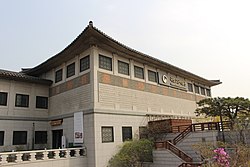National Palace Museum of Korea
 | |
 | |
| Established | September 1908 |
|---|---|
| Location | Sajikno 34 (Sejongno), Jongno-gu, Seoul, South Korea |
| Visitors | 1,513,000 (2016)[1] |
| Director | Soh Jae-gu |
| Website | gogung.go.kr |
| Korean name | |
| Hangul | 국립고궁박물관 |
| Hanja | 國立古宮博物館 |
| Revised Romanization | Gungnip gogung bangmulgwan |
| McCune–Reischauer | Kungnip kokung pangmulgwan |
The National Palace Museum of Korea is a national museum of South Korea located in Gyeongbokgung Palace, Seoul.

History
The museum first began as the "Korean Imperial Museum", which was established in September 1908 and was originally located in Changgyeonggung Palace. On November of the following year, the museum was opened to the public. However, on April 1938, the ruling Japanese government renamed the museum to the "Museum of Yi dynasty".[2]
In March 1946, after the liberation of Korea, it was renamed "Deoksugung Museum". In 1991, Cultural Heritage Administration instituted the museum in Seokjojeon (석조전, Stone Hall) of Deoksugung Palace, and in 2005, the museum was relocated to a modern building inside Gyeongbokgung Palace.
Collection
National Palace Museum of Korea houses over 40,000 artifacts and royal treasures, from the palaces of the Joseon Dynasty and the Korean Empire, of which 14 are National Treasures of South Korea.[3] It displays records, state rites, architecture, clothing, royal life, education, culture, paintings and music of the dynasty's ruling era.[4] It also has among its collection the royal seal of King Gojong of Joseon, which was used for his personal letters to Russian czar and Italian emperor after 1903. It disappeared during Japanese rule and was re-covered from a US-based Korean collector in 2009.[5]
Permanent exhibitions
- Royal Symbols and Records
- State Rites
- Joseon Science
- Palace Architecture
- Royal Life
- Royal Childbirth and Education
- Royal Scholarly Culture
- Korean Empire
- Royal Court Paintings
- Royal Court Music
- Royal Palanquins
- Joseon Water Clock

Special collection
The Museum houses 1,200 volumes of historical texts including 150 copies of Uigwe from the Joseon Dynasty that were looted in 1922, during rule by Japan under the supervision of then Resident-General of Korea Itō Hirobumi. They were repatriated in December 2011 and a special exhibition was held from 27 December 2011 to 5 February 2012.[6] The copies chronicled the royal rituals of King Gojong and King Sunjong, the last two emperors of Joseon Dynasty and Daehan Empire before Korea was annexed in 1910.[7]
See also
References
- ^ "TEA-AECOM 2016 Theme Index and Museum Index: The Global Attractions Attendance Report" (PDF). Themed Entertainment Association. pp. 68–73. Retrieved 23 March 2018.
- ^ "history of the museum" (in Korean). National Palace Museum of Korea website. Archived from the original on 3 March 2016. Retrieved 24 April 2008.
- ^ "history of the museum". National Palace Museum of Korea website. Archived from the original on 5 March 2016. Retrieved 24 April 2008.
- ^ "Seoul's best museums" Archived 28 September 2012 at the Wayback Machine CNN. 27 October 2011. Retrieved 4 November 2011
- ^ "Recovered Imperial Seal Goes on Display". Chosun Ilbo. 18 March 2009. Retrieved 30 May 2012.
- ^ "Looted Korean Texts Return Home from Japan". Chosun Ilbo. 6 December 2011. Retrieved 23 April 2012.
- ^ Lee, Claire "Looted Korean royal texts return home" The Korea Herald. 6 December 2011. Retrieved 23 April 2012
